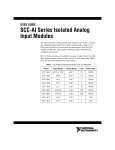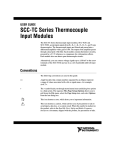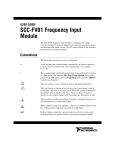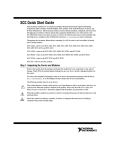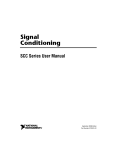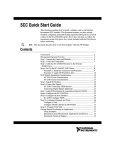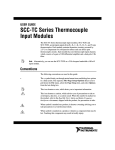Download National Instruments SCC-AI02 User's Manual
Transcript
USER GUIDE SCC-AI Series Isolated Analog Input Modules The SCC-AI Series isolated analog input modules (SCC-AIXX) can extract a relatively low-amplitude input signal from a high-common-mode voltage so the E Series DAQ device can measure the input signal. They also can amplify and filter the input signal, resulting in higher measurement resolution and accuracy. SCC-AIXX modules are available in a range of gains from 0.2 to 200. They contain lowpass filters of either 10 kHz or 4 Hz bandwidth. Table 1-1 gives the gain and bandwidth for each module. Table 1-1. SCC-AIXX Module Input/Output Range, Gain, and Bandwidth Model Input Range Output Range Gain Bandwidth SCC-AI01 ±42 V ±8.4 V 0.2 10 kHz SCC-AI02 ±20 V ±10 V 0.5 10 kHz SCC-AI03 ±10 V ±10 V 1 10 kHz SCC-AI04 ±5 V ±10 V 2 10 kHz SCC-AI05 ±1 V ±10 V 10 10 kHz SCC-AI06 ±100 mV ±10 V 100 10 kHz SCC-AI07 ±50 mV ±10 V 200 10 kHz SCC-AI13 ±10 V ±10 V 1 4 Hz SCC-AI14 ±5 V ±10 V 2 4 Hz Conventions The following conventions are used in this guide: <> Angle brackets that contain numbers separated by an ellipsis represent a range of values associated with a bit or signal name—for example, ai<0..7>. This icon denotes a note, which alerts you to important information. This icon denotes a caution, which advises you of precautions to take to avoid injury, data loss, or a system crash. When this symbol is marked on the product, refer to the Read Me First: Safety and Radio-Frequency Interference document, shipped with the product, for precautions to take. When symbol is marked on a product, it denotes a warning advising you to take precautions to avoid electrical shock. When symbol is marked on a product, it denotes a component that may be hot. Touching this component may result in bodily injury. bold Bold text denotes items that you must select in the software, such as menu items and dialog box options. Bold text also denotes parameter names. italic Italic text denotes variables, emphasis, a cross reference, or an introduction to a key concept. This font also denotes text that is a placeholder for a word or value that you must supply. monospace Text in this font denotes text or characters that you should enter from the keyboard, sections of code, programming examples, and syntax examples. This font is also used for the proper names of disk drives, paths, directories, programs, subprograms, subroutines, device names, functions, operations, variables, filenames and extensions, and code excerpts. SC-2345 SC-2345 refers to both the SC-2345 connector block and the SC-2345 configurable connector. SCC SCC refers to any SCC series signal conditioning module. What You Need to Get Started To set up and use the SCC-AIXX, you need the following items: ❑ SC-2345 with one of the following: – SCC-PWR01 – SCC-PWR02 and the PS01 power supply – SCC-PWR03 (requires a 7 to 42 VDC power supply, not included) SCC-AI Series Isolated Analog Input Modules 2 ni.com ❑ One or more SCC-SGXX ❑ SCC-SG Series Strain-Gauge Modules User Guide ❑ SC-2345 User Manual ❑ Read Me First: Safety and Radio-Frequency Interference ❑ SC-2345 Quick Reference Label ❑ 68-pin Basic or E Series DAQ device, documentation, and 68-pin cable ❑ 1/8 in. flathead screwdriver ❑ Numbers 1 and 2 Phillips screwdrivers ❑ Wire insulation strippers ❑ NI-DAQ (current version) for Windows 2000/NT/XP/Me Note Software scaling of measurements is not supported on the Macintosh operating system. Refer to the Scaling Voltage Measurements section. Unpacking the Module SCC modules are shipped in antistatic envelopes to prevent electrostatic damage (ESD) to the modules. ESD can damage several components on these products. Caution Never touch the exposed pins of connectors. To avoid damage from ESD when you handle the module, take the following precautions: • Ground yourself by using a grounding strap or by touching a grounded object. • Touch the antistatic envelope to a metal part of the computer chassis before removing the module from the envelope. Remove the module from the envelope and inspect the module for loose components or any sign of damage. Notify NI if the module appears damaged in any way. Do not install a damaged module. Store the module in the antistatic envelope when it is not in use. © National Instruments Corporation 3 SCC-AI Series Isolated Analog Input Modules Installing the Module Caution Refer to the Read Me First: Safety and Radio-Frequency Interference document before removing equipment covers or connecting/disconnecting any signal wires A blue label stripe identifies the SCC-AIXX as an analog input module. The label also displays the icon shown in Figure 1-1. Figure 1-1. SCC-AIXX Icon You can plug the SCC-AIXX into any analog input socket on the SC-2345. The socket you choose determines which E Series DAQ device channels receive the SCC-AIXX signals. For single-stage input conditioning, plug the SCC-AIXX into any socket J(X+1), where X is 0 to 7, and connect the input signals to the module as described in the Connecting the Input Signals section. If you use the SCC-AIXX in a dual-stage configuration, the SCC-AIXX must be the first-stage module. Plug it into any socket J(X+9) and plug the second-stage SCC into socket J(X+1), where X is 0 to 7. Connect the input signals to the SCC-AIXX as described in the Connecting the Input Signals section. The SC-2345 connects the output signals of the first-stage SCC to the inputs of the second-stage SCC. An example of dual-stage conditioning is an SCC-AI02 followed by an SCC-FV01 frequency input module. Sockets J9 to J16 are also available for digital input/output (DIO) conditioning or control. Refer to the SC-2345 User Manual for more information on configuring, connecting, and installing SCC modules. SCC-AI Series Isolated Analog Input Modules 4 ni.com Connecting the Input Signals The SCC-AIXX has a fixed screw-terminal receptacle and a removable screw-terminal block, as shown in Figure 1-2. 1 4 3 2 1 2 1 SCC Screw-Terminal Receptacle 2 Removable Screw-Terminal Block Figure 1-2. SCC-AIXX Two-Part Screw-Terminal System After you install the SCC-AIXX, connect the input signals to the removable screw-terminal block of the module. 1. Remove power from the signal lines. 2. Strip 7 mm of insulation from the ends of the signal wires. 3. Insert the wires into the screw terminals. 4. Tighten the screws to 0.5 to 0.6 N · m (4.4 to 5.3 lb - in.) of torque. Each screw terminal is labeled by pin number <1..4>. Pins 1 and 2 form a channel routed to E Series DAQ device channel X+8, and pins 3 and 4 form a channel routed to the E Series DAQ device channel X, where X is 0 to 7 depending on the socket where you plug in the module. The SCC-AIXX provides channel-to-ground and module-to-module isolation only. It does not provide isolation between the two channels of the SCC-AIXX. Because both channels must have the same reference voltage, pins 1 and 3 are connected together internally. Figure 1-3 shows the SCC-AIXX signal connections. © National Instruments Corporation 5 SCC-AI Series Isolated Analog Input Modules Signal Source E Series DAQ Device SCC-AIXX 4 + + Lowpass Filter – ACH(X ) – 3 AISENSE AIGND 2 + + Lowpass Filter – 1 ACH(X+8) – Figure 1-3. SCC-AIXX Signal Connections The inputs are designed in a floating (nonreferenced) single-ended configuration. If the measured signals are floating, connect the negative input pins, 1 and 3, to AISENSE on the SC-2345 terminal block through a 10 kΩ to 100 kΩ resistor. Figure 1-4 shows a floating signal connection on one channel of the SCC-AIXX. E Series DAQ Device SCC-AIXX 4 Signal Source + + Lowpass Filter – ACH(X ) – 3 10–100 kΩ AISENSE AISENSE on SC-2345 terminal block AIGND 2 + Lowpass Filter 1 ACH(X+8) – Figure 1-4. Nonreferenced Signal Connection for the SCC-AIXX (One Channel) SCC-AI Series Isolated Analog Input Modules 6 ni.com If a high common-mode voltage is present, connect the negative input pins, 1 and 3, to the signal reference. Figure 1-5 shows a ground-referenced signal connection on one channel of the SCC-AIXX. E Series DAQ Device SCC-AIXX 4 Signal Source + + Lowpass Filter – High CMV ACH(X ) – 3 + AISENSE – AIGND 2 + Lowpass Filter 1 ACH(X+8) – Figure 1-5. Ground-Referenced Signal Connection for the SCC-AIXX with High Common-Mode Voltage (One Channel) Configuring the SCC System Measurement & Automation Explorer (MAX) Configuration Run MAX to configure the SCC system. Complete one of the following sets of steps depending on the version of NI-DAQ used in your application. NI-DAQmx Complete the following steps to configure the SCC-AI module using NI-DAQmx. 1. Open Measurement & Automation Explorer. 2. Right-click Devices and Interfaces and select Create New. 3. Under NI-DAQmx SCC Connector Block select SC-2345. Click Finish. © National Instruments Corporation 7 SCC-AI Series Isolated Analog Input Modules 4. 5. In the SCC Connector Block Configuration window, configure the SCC system as follows: a. Specify the SCC Carrier Type. The location of the SCC sockets change depending on the SCC carrier type. b. Select the DAQ Device that is connected to the SC-2345. c. Type the SCC Connector Block ID. The default value is SCC1. d. In the J21 drop-down list next to Power, select the correct SC-2345 power configuration. Refer to the SC-2345 User Manual for information on power configurations. e. For each SCC module physically installed in the SC-2345, add a corresponding entry in the SC-2345 configuration window. To add the SCC, click the socket drop-down list and select the correct module. If the module name does not appear in the list, either the module is not allowed in that location or you do not have the current version of NI-DAQ. If you do not have the current version of NI-DAQ, download it from ni.com. f. Click OK after completing all SCC entries to complete the configuration process. Close MAX. Note Configuring the SCC system using MAX automatically sets the E Series DAQ device analog input mode to nonreferenced single-ended (NRSE). Traditional NI-DAQ Complete the following steps to configure the SCC-AI module using Traditional NI-DAQ. 1. Open Measurement & Automation Explorer. 2. Expand Devices and Interfaces. 3. Expand Traditional NI-DAQ Devices. 4. Right-click the E Series DAQ device connected to the SC-2345, and select Properties. 5. Select the Accessory tab. 6. Under Accessory, select SC-2345. 7. Click the Configure button. A new window appears listing the sockets (connector reference designators) of the SC-2345. 8. Select the SC-2345 socket where you installed an SCC. 9. Click Add and select the SCC you installed. If the module name does not appear in the list, either the module is not allowed in that location or you do not have the current version of NI-DAQ. If you do not have the current version of NI-DAQ, download it from ni.com. SCC-AI Series Isolated Analog Input Modules 8 ni.com 10. If you make a selection mistake, select the socket and click Remove. 11. Repeat steps 8 and 9 for each newly installed SCC. 12. Click OK after completing all SCC entries. 13. Click OK to complete the configuration process and close MAX. Note Configuring the SCC system using MAX automatically sets the E Series DAQ device analog input mode to nonreferenced single-ended (NRSE). Virtual Channels, Physical Channels, and Tasks After you have installed and configured your SCC hardware, you can use software tools within MAX to further configure the module and take measurements. Creating an NI-DAQmx Task or Global Channel To create an NI-DAQmx task or global channel, complete the following steps. 1. Open Measurement & Automation Explorer. 2. Right-click Data Neighborhood and select Create New. 3. Select NI-DAQmx Task or NI-DAQmx Global Channel and click Next. 4. Select Analog Input and then select Voltage. 5. If you are creating a task, select the channels to add to the task. You can select blocks of channels by pressing the <Shift> key while making the selections or select individual channels by pressing the <Ctrl> key while making the selections. If you are creating a channel, you can select only one channel. Click Next. 6. Enter a name for the task or global channel and click Finish. 7. In the Channel List box, select the channel(s) you want to configure. You can select blocks of channels by pressing the <Shift> key while making the selections or select individual channels by pressing the <Ctrl> key while making the selections. 8. Enter the specific values for your application in the Settings tab. Context help information for each setting is provided on the right side of the screen. © National Instruments Corporation 9 SCC-AI Series Isolated Analog Input Modules Table 1-2 shows suggested values for some of the parameters. Use default values for parameters not shown. Table 1-2. SCC-AIXX Suggested Values 9. Module Input Range SCC-AI01 ±42 V SCC-AI02 ±20 V SCC-AI03 ±10 V SCC-AI04 ±5 V SCC-AI05 ±1 V SCC-AI06 ±100 mV SCC-AI07 ±50 mV SCC-AI13 ±10 V SCC-AI14 ±5 V Click Test to test the channel. You should be able to view your measurement in the window that appears. You have finished configuring the NI-DAQmx task or global channel. Creating a Virtual Channel in Traditional NI-DAQ To create a Traditional NI-DAQ virtual channel, complete the following steps. 1. Open Measurement & Automation Explorer. 2. Right-click Data Neighborhood and select Create New. 3. Select Traditional NI-DAQ Virtual Channel and click Finish. 4. Click Next to select Analog Input as the type of channel to configure. 5. Select Voltage from the drop-down list and click Next. 6. Enter the rest of the values as they apply to your setup and click Next. 7. On the next screen, specify information about the E Series DAQ device being used and click Finish. 8. To test the channel, click Test. You have finished configuring the Traditional NI-DAQ virtual channel. SCC-AI Series Isolated Analog Input Modules 10 ni.com Scaling Voltage Measurements If you configured the SCC-AIXX using MAX and you are using NI-DAQ, the voltage reading you get from the E Series DAQ device accounts for the voltage scaling effect of the SCC-AIXX. Otherwise, since the voltage measurement from the E Series DAQ device is scaled by the gain given in Table 1-1, you must divide the voltage reading returned by the E Series DAQ device by this gain to get the correct input voltage. Specifications These ratings are typical at 25 °C unless otherwise stated. Input Characteristics Number of input channels ...................... 2 NRSE Isolation.................................................. Bank isolation (isolation per module)1 Input/output signal range, gain, and bandwidth ........................................ Refer to Table 1-1 Input impedance SCC-AI01, SCC-AI02 .................... 1 MΩ All others......................................... 100 MΩ Gain error ............................................... 4.5% max (trimmable to zero) Gain stability .......................................... 150 PPM/°C Offset error ............................................. 40 mV max (RTI2) Offset stability........................................ 225 µV/°C Nonlinearity ........................................... 0.0128% typ 0.0260% max Common-mode rejection ratio ............... 100 dB typical at 60 Hz Output slew rate, dependent on BW (filtering) .................. 0.8 V/µs max 1 2 The SCC-AIXX does not provide isolation between the two channels of the module. For more information on this topic, refer to the Connecting the Input Signals section. This specification is calculated relative to the input range of the module. © National Instruments Corporation 11 SCC-AI Series Isolated Analog Input Modules Filter Characteristics Number of poles .....................................3 Rolloff.....................................................60 dB/decade Cutoff frequency (–3 dB) AI0X ................................................10 kHz AI1X ................................................4 Hz Power Requirement Analog power .........................................519 mW max +15 V ...............................................34.6 mA max –15 V ...............................................34.6 mA max Digital power (+5 V) ..............................625 mW max 125 mA max Physical Dimensions .............................................8.89 cm by 2.92 cm by 1.85 cm (3.5 in. by 1.15 in. by 0.73 in.) I/O connectors.........................................One, 20-pin right-angle male connector one, 4-pin screw terminal, removable Screw terminal wire gauge .....................24 to 12 AWG Maximum Working Voltage Maximum working voltage refers to the signal voltage plus the common-mode voltage. Channel-to-earth .....................................300 V, Installation Category II Module-to-module ..................................300 V, Installation Category II Channel-to-channel.................................Not isolated1 1 The SCC-AIXX does not provide isolation between the two channels of the module. For more information on this topic, refer to the Connecting the Input Signals section. SCC-AI Series Isolated Analog Input Modules 12 ni.com Environmental Operating temperature............................ 0 to 50 °C Storage temperature ............................... –20 to 70 °C Humidity ................................................ 10 to 90% RH, noncondensing Maximum altitude .................................. 2,000 meters Pollution Degree (indoor use only) ........ 2 Safety The SCC-AIXX meets the requirements of the following standards for safety and electrical equipment for measurement, control, and laboratory use: • IEC 61010-1, EN 61010-1 • UL 3111-1, UL 61010B-1 • CAN/CSA C22.2 No. 1010.1 Note For UL and other safety certifications, refer to the product label, or visit ni.com/hardref.nsf, search by model number or product line, and click the appropriate link in the Certification column. Electromagnetic Compatibility Emissions ............................................... EN 55011 Class A at 10 m FCC Part 15A above 1 GHz Immunity ................................................ Evaluated to EN 61326:1997/ A2:2001, Table 1 CE, C-Tick and FCC Part 15 (Class A) Compliant Note For full EMC compliance, you must operate this device with shielded cabling. In addition, all covers and filler panels must be installed. CE Compliance The SCC-AIXX meets the essential requirements of applicable European Directives, as amended for CE marking, as follows: Note Refer to the Declaration of Conformity (DoC) for this product for any additional regulatory compliance information. To obtain the DoC for this product, visit ni.com/hardref.nsf, search by model number or product line, and click the appropriate link in the Certification column. © National Instruments Corporation 13 SCC-AI Series Isolated Analog Input Modules Calibrating Gain and Offset Errors The SCC-AIXX is calibrated at the factory before shipment. If you want to adjust the gain of the SCC-AIXX in your system using your E Series DAQ device, you need a voltage source that is several times more accurate than the SCC itself and capable of providing the DC voltage shown in Table 1-3. Table 1-3. SCC-AIXX Input Voltage Requirements Module Input Range SCC-AI01 40 V SCC-AI02 16 V SCC-AI03 8V SCC-AI04 4V SCC-AI05 800 mV SCC-AI06 80 mV SCC-AI07 40 mV SCC-AI13 8V SCC-AI14 4V To adjust the gain of the SCC-AIXX, complete the following steps: 1. Select the desired SCC-AIXX channel on the E Series DAQ device. 2. Set the gain on the E Series DAQ device so that its input range is ±10 V. 3. Connect the voltage source to the screw terminals of the desired channel on the SCC-AIXX. 4. Apply the voltage given in Table 1-3 that corresponds to the SCC-AIXX module. For example, if you have an SCC-AI03, you must apply 8 VDC. 5. Using your software, have the E Series DAQ device read the desired channel on the SCC-AIXX and record the value. 6. Input 0 VDC to the SCC-AIXX. 7. Use the E Series DAQ device to read that channel and record the value. 8. Subtract the values read (first reading – second reading). SCC-AI Series Isolated Analog Input Modules 14 ni.com 9. Adjust the trimpot labeled Gain located on the top of the SCC-AIXX. If the value you obtained in step 8 is less than the input voltage, turn the trimpot clockwise to increase the gain. If it is greater than the input voltage, turn the trimpot counterclockwise to decrease the gain. 10. Repeat steps 4 through 9 until the difference you get in step 8 equals the Input Voltage Required value shown in Table 1-3; in this example the value is 8 V using an SCC-AI03. For example, assume that you have an SCC-AI03 module. You first connect 8 VDC to the input of CH(X). The E Series DAQ device reads 8.05 V as the SCC output. You then connect 0 VDC to the input of CH(X) and the E Series DAQ device reads –0.01 V as the SCC output. You subtract these readings, 8.05 – (–0.01) = 8.06, getting a difference of 8.06 V. Because this difference is not equal to 8 V, you must adjust the gain trimpot and repeat the procedure until the difference in outputs equals 8 V. Note In this example there can be an offset voltage such that the final readings are 8.01 V and 0.01 V for a difference of 8 V. The gain trimpot adjusted in step 9 of the previous procedure adjusts only for gain errors and does not compensate for this offset voltage. Complete the following steps to adjust the offset voltage of the SCC-AIXX. 1. Select the desired SCC-AIXX channel on the E Series DAQ device. 2. Set the gain on the E Series DAQ device so that the input range is ±10 V. 3. Connect the screw terminals of your desired channel on the SCC-AIXX together. 4. Using your software, have the E Series DAQ device read the channel. 5. If the value read is not equal to 0.00 V, adjust the appropriate trimpot located on the top of the SCC-AIXX, labeled Offset. Turn the trimpot clockwise to increase the offset. 6. Repeat steps 4 and 5 until the voltage read in step 4 equals 0.00 V. © National Instruments Corporation 15 SCC-AI Series Isolated Analog Input Modules SCC-AIXX Module Pin Assignments Figure 1-6 shows the I/O connector pins on the bottom of the module. 4 1 2 3 5 1 Pin 1 2 Pin 2 3 PWB Key 4 Pin 19 5 Pin 20 Figure 1-6. SCC Module Bottom View Table 1-4 lists the signal corresponding to each I/O connector pin on the bottom of the SCC-AIXX. ACH(X) and ACH(X+8) are the analog input channels of the E Series DAQ device. AIGND is the analog input ground signal and is the reference for ACH(X) and ACH(X+8). AGND is the reference for the ±15 V supplies and REF5V. AIGND and AGND connect to the SC-2345 at the SCC-PWR connector. GND is the reference for the +5 V supply. Table 1-4. SCC-AIXX Module Pin Assignments SCC-AI Series Isolated Analog Input Modules Pin Number Signal 1 E Series ACH(X) 2 E Series AIGND 3 — 4 E Series ACH(X+8) 5 — 6 E Series AIGND 7 — 8 E Series AIGND 16 ni.com Table 1-4. SCC-AIXX Module Pin Assignments (Continued) © National Instruments Corporation Pin Number Signal 9 +6 V 10 GND 11 AGND 12 REF5V 13 +15 V 14 –15 V 15 — 16 — 17 — 18 — 19 — 20 — 17 SCC-AI Series Isolated Analog Input Modules National Instruments™, NI™, ni.com™, and NI-DAQ™ are trademarks of National Instruments Corporation. Product and company names mentioned herein are trademarks or trade names of their respective companies. For patents covering National Instruments products, refer to the appropriate location: Help»Patents in your software, the patents.txt file on your CD, or ni.com/patents. © 2002–2003 National Instruments Corp. All rights reserved. *371066A-01* 371066A-01 Sep03


















